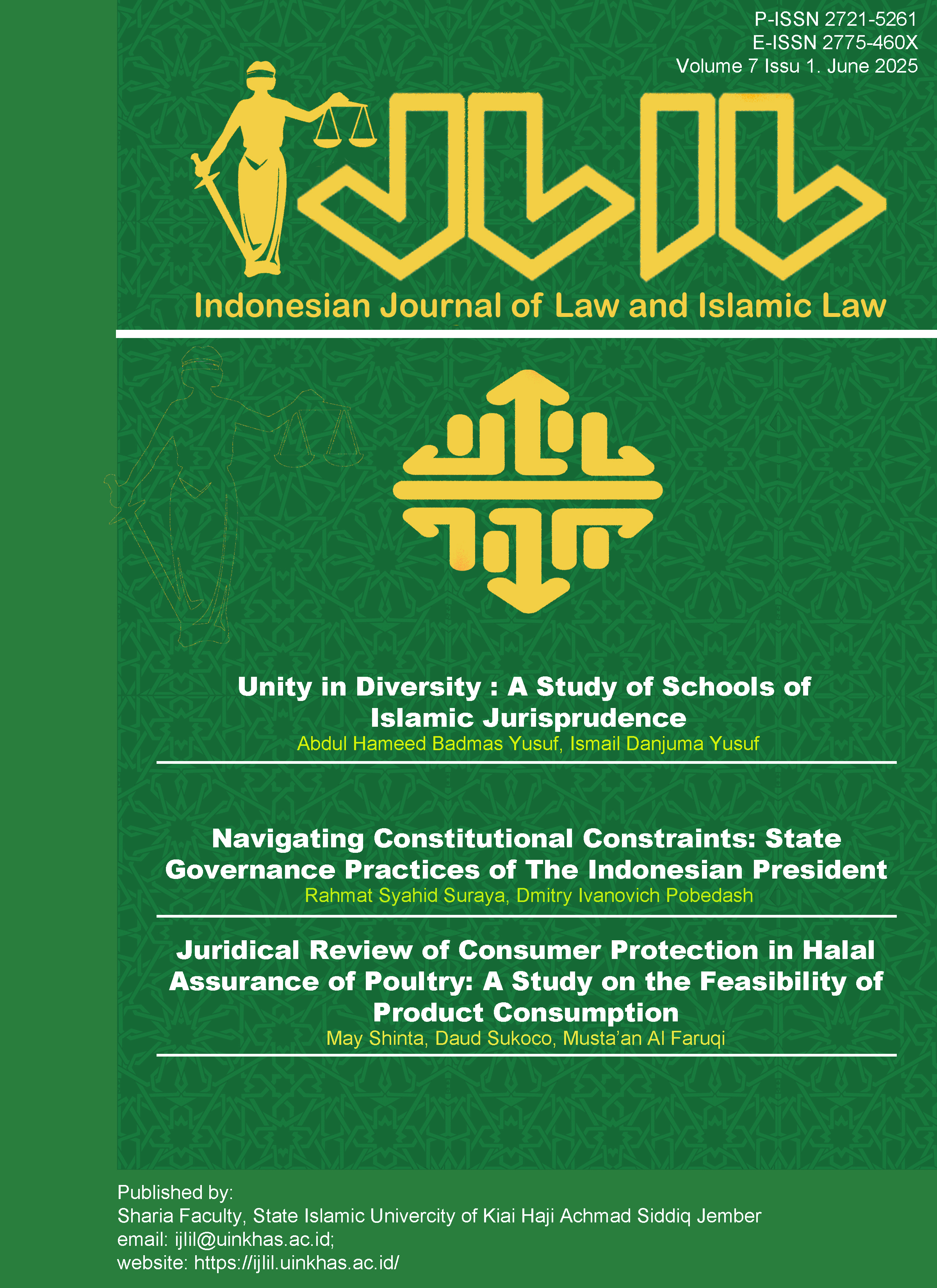Navigating Constitutional Constraints: State Governance Practices of The Indonesian President
DOI:
https://doi.org/10.35719/ijlil.v7i1.332Keywords:
Limitation Power of President, Constitutional Governance, Checks and Balances system, IndonesiaAbstract
The focus of this study is to examine the substance of the president's authority restrictions in establishing constitutional governance in Indonesia. The president's limitation of power is connected to the president's restriction of authority. On the other hand, the president's power can be limited by the functional relationship between the president and the House of Representative Council (DPR), the Representative People Assembly (MPR), the Local Representative Council (DPD), and the Supreme Court (MA) and the Constitutional Court (MK). The study's findings indicate that the restricted content of the president's power can be viewed not only in terms of the president's time in office but also in terms of the content president's authority, i.e. restrictions on choosing state officers and restrictions on law-making and that the restricted content president power can be viewed in terms of the president's functional relationship with legislative and constitutive institutions.
References
Asrinaldi, and Mohammad Agus Yusoff. “Power Consolidation and Its Impact on the Decline of Democracy in Indonesia under President Jokowi.” Cogent Social Sciences 9, no. 1 (2023). https://doi.org/10.1080/23311886.2023.2232579.
Bambang Ariyanto, Umar Sholahudin. “Hubungan Presiden-DPR Dalam Pembentukan UU Dalam Rangka Memperkuat Prinsip Kedaulatan Rakyat.” Jurnal Majelis Media Aspirasi Konstitusi 2, no. 2 (2022): 305. https://repository.unair.ac.id/123847/1/9. A.pdf.
Beby Suryani Fithri. “Hubungan Antar Lembaga Negara Berdasarkan UUD 1945 Pasca Amendemen.” Universitas Medan Area, 2020. https://webcache.googleusercontent.com/search?q=cache:BDsuQOHoCi4J:https://media.neliti.com/media/publications/9138-ID-perlindungan-hukum-terhadap-anak-dari-konten-berbahaya-dalam-media-cetak-dan-ele.pdf+&cd=3&hl=id&ct=clnk&gl=id.
Hardiyanto, Lutfi, Ayu Fahira Lestari, Dina Rizqi Fadilah, Eka Wulandari, Iyan Haryanto, and Radhitio Ridho Akbar. “Isu Presiden 3 Periode Dalam Kajian Konstitusi.” Jurnal Citizenship Virtues 2, no. 2 (2022): 311–19. https://doi.org/10.37640/jcv.v2i2.1532.
Khairulloh, Muhammad Dafa. “Sejarah Dan Perkembangan Mahkamah Konstitusi Selaku Pemegang Kekuasaan Kehakiman Di Indonesia.” Souvereignty 2, no. 1 (2023): 125–29.
Kuntana Magnar. “Hubungan Dewan Perwakilan Rakyat (DPR) Dengan Presiden Setelah Perubahan Undang-Undang Dasar (UUD) 1945: Pencarian Bentuk Dan Isi.” Graduate program Padjajaran University, 2006.
Lailam, Tanto, Putri Anggia, and Irwansyah Irwansyah. “The Proposal of Constitutional Complaint for the Indonesian Constitutional Court.” Jurnal Konstitusi 19, no. 3 (2022): 693–719. https://doi.org/10.31078/jk1939.
Latansa, Qonita Dina. “Konstitusionalitas Batasan Masa Jabatan Presiden Dan Wakil Presiden Di Indonesia.” Jurist-Diction 2, no. 2 (2019): 595. https://doi.org/10.20473/jd.v2i2.14254.
Lee, So Yoon. “An Urban Explanation of Jokowi’s Rise: Implications for Politics and Governance in Post-Suharto Indonesia.” Journal of Current Southeast Asian Affairs 40, no. 2 (2021): 293–314. https://doi.org/10.1177/1868103421990853.
Lestari, N, A Ramadhani, and ... “Dynamics of Development Democracy Indonesia in the Era of Jokowi Leadership.” Jurnal Netralitas Dan … 1, no. 1 (2022): 40–50. https://doi.org/https://doi.org/10.55108/JNP.v1i1.179.
Pakazeni, Irmaline, and Cindy Nabilla. Analisis Sistem Pemerintahan Di Indonesia Pada Demokrasi Di Era SBY Dan Jokowi. TheJournalish: Social and Government. Vol. 1. Universitas Indo Global Mandiri, Palembang: Jurnal Ilmu Pemerintahan, 2020. https://doi.org/10.55314/tsg.v1i3.24.
Pratiwi, Juang Intan, Neneng Salama, and Siti Ulfah. “Pembatasan Masa Jabatan Presiden Di Indonesia.” Jurnal Rechten: Riset Hukum Dan Hak Asasi Manusia 3, no. 1 (2021): 18–21.
Prayitno, Cipto. “Analisis Konstitusionalitas Batasan Kewenangan Presiden Dalam Penetapan Peraturan Pemerintah Pengganti Undang-Undang.” Jurnal Konstitusi 17, no. 3 (2020): 513. https://doi.org/10.31078/jk1733.
Rabbani, Deden Rafi Syafiq, Ali Abdurahman, and Mei Susanto. “The Preamble Of The Constitution As A Constitutional Touchstone: Indonesian Practices.” Arena Hukum 15, no. 2 (2022): 353–79. https://doi.org/10.21776/ub.arenahukum.2022.01502.7.
Republik Indonesia. “Constitution of Indonesia 1945 (Ammanded in 2002).” MKRI. Jakarta, 2002. https://jdih.mkri.id/mg58ufsc89hrsg/UUD_1945_Perubahan.pdf.
RI., Bawaslu. No Title. Desain Pegawasan Pemilihan Serentak [PDF], 2020. https://www.bawaslu.go.id/sites/default/files/publikasi/BUKU.
RI, BAPPENAS. “Presiden Republik Indonesia Peraturan Presiden Republik Indonesia.” Demographic Research, 2020.
Suparto, Suparto. “Pelaksanaan Sistem Pemerintahan Presidensial Dengan Multi Partai Di Indonesia.” Sasi 27, no. 4 (2021): 516. https://doi.org/10.47268/sasi.v27i4.600.
Suryono, Adityadarma Bagus Priasmoro. “Analisis Perkembangan Lembaga Negara Pasca Reformasi Ditinjau Dari Perspektif Politik Hukum.” Jurnal Hukum Lex Generalis 1, no. 7 (2020): 20–39. https://doi.org/10.56370/jhlg.v1i7.229.
Syauyiid Alamsyah, and Nurdin. “Lembaga Representatif Publik: Relasi Kekuasaan Dalam Perspektif Perbandingan Sistem Presidensial Vs Sistem Parlementer Studi Kasus Indonesia Dengan Inggris.” Jurnal Adhikari 2, no. 3 (2023): 392–405. https://doi.org/10.53968/ja.v2i3.78.
The Economist Intelligence Unit. “Democracy Index 2021 - Economist Intelligence Unit.” Eiu.Com, 2021. https://www.eiu.com/n/campaigns/democracy-index-2021/#mktoForm_anchor.
Warsito. “Kedudukan MPR Sebelum Dan Sesudah Amandemen UUD 1945.” Surya Kencana Dua 9 (2022): 174–82. https://doi.org/http://dx.doi.org/10.32493/SKD.v9i2.y2022.26276.
Downloads
Published
How to Cite
Issue
Section
License
Copyright (c) 2025 Rahmat Syahid Suraya, Dmitry Ivanovich Pobedash

This work is licensed under a Creative Commons Attribution-ShareAlike 4.0 International License.






